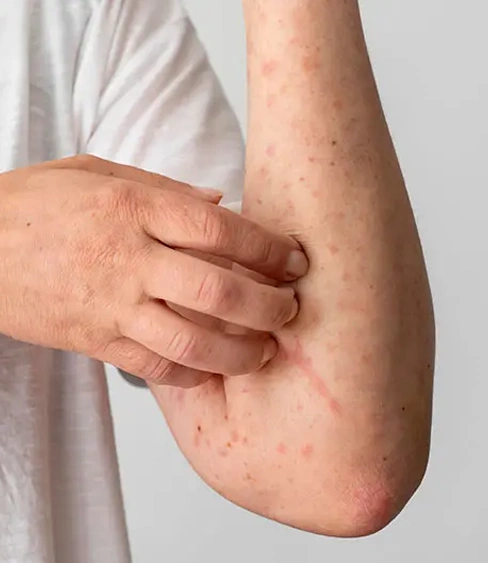
Ayurveda Treatment for skin Rashes and Itching
- The skin defends the body from physical injuries, chemical assaults, infectious disease entrance, bites, and other.
- It aids in the body’s proper moisture.
- It assists in the perception of objects through the sense of Gross and fine motor movements allow the person to “connect” with the environment.
- Our bodies’ different blood veins are located at the skin’s surface. These arteries dilate and contract to regulate temperature with the subcutaneous fat.
- It produces the pigment melanin, protecting the body from harmful UV rays.
- It aids in healing cuts, wounds, and fissures caused by damage, accident, or
- It helps absorb Vitamin D, which aids the body’s defence against harmful illnesses. Vitamin D deficiency can cause neurological diseases, heart disease, osteoporosis, obesity, and
- Individual factors such as age, allergies, sensitivity, dryness, oiliness, UV damage, wrinkles, and congestion affect different skin.
Types of skin disease
- Pruritus, often known as itchy skin, is a condition in which a person’s skin is continually irritated and feels compelled to scratch. This might be the result of an underlying skin problem or other ailments.
- Itching, cracking, and scaling are frequent symptoms of dry skin on the arms, legs, and abdomen. Excessively dry skin is frequently the result of a lifestyle
- Allergic eczema is typically red, inflamed, itchy, raw, scaly, and burn-like. Blisters can form if the skin has not cared. When these blisters dry, they may seep out and become crusty
- Hives are raised, itchy welts appear when the body is exposed to an allergen. These reddish welts can be circular or uneven, tiny or large/ring- shaped, and pain when touched
- Rashes are allergic responses, fungal infections, and parasite infections that can create red, inflamed, and painful skin lumps
- Acne, often known as pimples, is a frequent ailment among teenagers. The skin’s pores get blocked when natural skin oil interacts with dust and grime, causing zits or pimples to appear
Panchakarma
Panchakarma is one of those therapies that help in reducing skin-related issues. Panchakarmas are 5 different methods of detoxification mentioned in Indian medicine. Skin diseases are mostly treated with Panchakarma treatment in Ayurvedia. Skin disorders including ezema, psoriasis and even acne are treated using this approach. This treatment mainly comprises procedures like
- consumption of medicated ghee for some days
- Oil massage of the whole body
- Sweat inducing
Pracchanna Raktamokshana is given during the instance of Kushta with a minor symptom. Here the blood is drawn with a coarse instrument. Sira Vyadha/Raktamokshana – vein puncture – is used when the condition is more severe.
Leaching
In many cases where the lession is hard, localised and well vascularized this method is effectivly used. In this method blood letting is done with the organism hirudinaria species are used.
Lepams
The processes of tropical application of different forms of use full drugs are called lepam/lepanam. Medicated oils, powders made in to paste with suitable liquid medium like tender coconut water, kashayams, oils, curd etc, fresh leaf’s of many plants etc are used for such purpose.
Abhyangam
Oilation with different medicated oils wich are suitable for pacifying the doshas involved.
Application of aloe vera gel
Aloe vera gel’s cooling action can help soothe irritated skin and irritation. Apply the gel to your skin once or twice a day to apply this cure.
Useful herbs for bathing
The paste or decoction of Vasa – Adhathoda vasica, Triphala (Haritaki, Bibhitaki, and Amalaki), Brhati – Solanum indicum are suitable for treating skin disease. Sevya is used for Udvartana (Unction) and Pralepa (external application) by a patient suffering from Kustha. The decoction of Khadira – Acacia catechu, Avaghata (Karnikara), Kakubha – Terminalia arjuna, Rohitaka, Lodhra – Symplocos racemosa, Kutaja – Hollarhena antidysentrica, Dhava – Anogeissus latifolia, Nimba – Azadirachta indica, Saptacchada (Saptaparna) – Alstonia scholaris – Stem bark and Karvira – Nerium indicum is useful for bath and drink by a patient suffering from Kustha.
Pathya – Diet
- Laghu ahara – A light and nutritious meal
- Tikta shaka – Bitter-tasting leafy vegetables
- Food preparations and medicated ghee that has been prepared by boiling the same with Bhallalaka, Triphala, and Nimba
- Cereals that are not recently harvested
- Animal meat inhabiting arid land (Jangala Mamsa) and preparations of Mudga (green gram) with Patola – pointed



